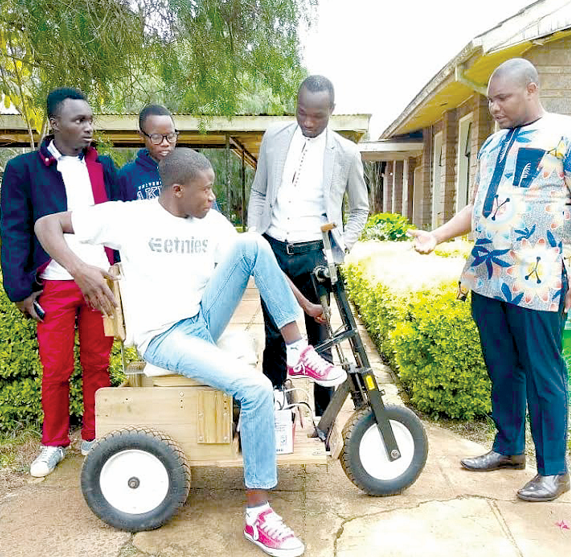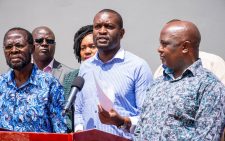How a mere headache led to a diagnosis that changed my life

Paul Wafula, 27, like many people, was born in good health until he became ill in 2017 while in his second year of university at St Paul’s University. He had lost bodily stability due to the severity of his illness.
It all started as a headache, which kept getting worse barely a week before his birthday, and he was rushed and admitted at the Kijabe Mission Hospital, where he stayed for a month.
“One minute I was fine and the next, I remember finding myself in a room that had a television set and people were with me always in the room,” he says.
That is when reality struck, the headache had overwhelmed him to becoming unconscious and from that very day, his life completely changed. Things he used to do for himself, such as walking to the washroom were now impossible to do. He could not bathe or even eat by himself. Realising that he was no longer independent truly broke him down.
No diagnosis
He narrates that his health got worse at Kijabe Mission Hospital and he had to be referred to Nairobi Hospital.
Doctors had performed a variety of tests on him, but they were not able to diagnose what was ailing him. It was not until a doctor from South Africa arrived and performed some tests that Wafula was diagnosed with the dreaded meningitis. The disease had adversely affected his brain and spinal cord at that point, and water that had accumulated in his skull had to be drained right away.
Kijabe Mission Hospital lacked the needed equipment to assist in the draining of the water from his brain. This forced his immediate transfer to Nairobi Hospital. “The cost of hiring an ambulance was Sh8,000 at that time, which was paid before departure,” Wafula adds.
Lost sight
He says that by this time, he had lost his sight and speech and could not walk. He had lost hope of ever getting better. “I asked God the common question that hopeless people always ask: Why me?” he pauses and takes a breather before painfully continuing with his story.
Wafula says he had to take an MRI (Magnetic Resonance Imaging) scan, which is a non-invasive imaging technology that produces three-dimensional detailed anatomical image at the Nairobi Hospital. His condition stabilised after spending a few days at the hospital and he was discharged. “When I was released from the hospital, I returned home where I stayed for a year without going to school,” he recounts.
In 2018, he went back to school to complete his degree. The then student leaders and the institution helped him raise some money and purchase a wheelchair for him as he still had difficulties walking.
He continues: “When I came back to continue with my studies, all accommodation rooms that were reserved for people with special needs were fully booked. I was to go back home and wait until one was vacant, but one of my friends offered me accommodation for free. I started living with this friend without paying a cent.”
Slurred speech
Wafula recalls two ladies, his friends, who would go to his room every morning to pick him up for classes and bring him back when he finished his day’s studies.
He goes on to describe how many things at school had changed since he became unwell. Apart from being acquainted with a wheelchair and slurred speech, Wafula says that he confronted other problems, but he is grateful to the institution for making every effort to make him comfortable. “I can’t say that I am enjoying life and that everything is going on smoothly, some challenges came with this condition. First, as I resumed my studies, there are things I can’t do fast. For example, the people who I began my undergraduate studies with have already graduated. Others came after I graduated last year and this is simply because the number of units that they do is not the same number of units that I do. The institution’s administration only allows me to do half of the total units that one is supposed to do per semester,” he shares.
“In any competition, it is painful to see an opponent who you were ahead of overtake and become the one leading. It hurts more in life when people you have seen growing up become successful leaving you still struggling; they even become the people you depend on,” he adds.
Wafula’s health has, however, slowly improved, and he can now type, walk with walking frames, and connect with people more effectively.
Wafula was a vital component of the institution’s praise and worship team prior to his illness. He also acted as the team’s worship coordinator.
He offers: “The sickness did not make me leave praise and worship, but some things that I used to do before, I cannot do them anymore. I have been in praise and worship all my life on campus. Now I am in my final semester. I have been serving as the chairperson of the team.”
“I was also a good hockey player; I used to be the first goalkeeper of the school team. Things happened and were beyond my control,” he says with a faint smile of optimism.
Recovery time
Meningitis, according to Dr Mbiti Mwondi of Bungoma County Referral Hospital, is caused by inflammation of the meninges-three layers of membranes that cover and protect your brain and spinal cord. “Its diagnosis can be done through taking ones medical history, clinical examination, and laboratory tests, such as blood culture and cerebrospinal fluid analysis. The tests can help identify the underlying causes of meningitis,” explains.
He opines that the recovery period for meningitis varies depending on the patient’s age, the intensity of illness, and general health. Minor instances can be resolved in two to four weeks, however, severe cases might require months.
Treatment for meningitis in Kenya typically includes antibiotics, fluids, and hospitalisation. The cost of treatment depends on the type of meningitis and the severity of the infection.
Paediatricians, neurologists, and infectious disease specialists usually provide specialist care. The specialist may prescribe antibiotics, such as penicillin, or antiviral medications. They may also recommend additional tests and treatments, such as lumbar punctures or Computerised Tomography (CT) scans.
The cost of treatment, Dr Mwondi says is reasonable, especially for those with insurance and National Hospital Insurance Fund (NHIF) coverage, because most instances of meningitis respond to the drug Ceftriaxone.
He goes on to say that the most significant barriers to treatment, include late diagnosis, expense, particularly for those paying out of pocket, and compliance and adherence to therapy because it needs 14 days of intravenous (IV) antibiotics.
Dr Davji Atellah, National Secretary General and CEO at Kenya Medical Practitioners, Pharmacists and Dentists Union (KMPDU), laments that despite Kenya boasting of free medical care, the health system still faces a colossal number of challenges. “We are currently having inadequate specialists, such as neurologists and also general practitioners. The general cost of treatment in Kenya is expensive for the common man,” he says.
“Most public facilities are understaffed, there are inadequate drugs and medical imaging to rule out complications,” he further says.












